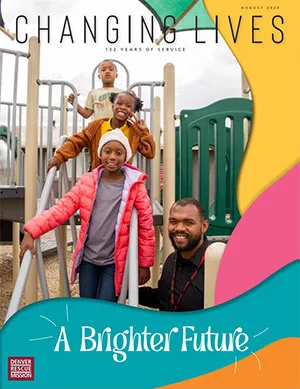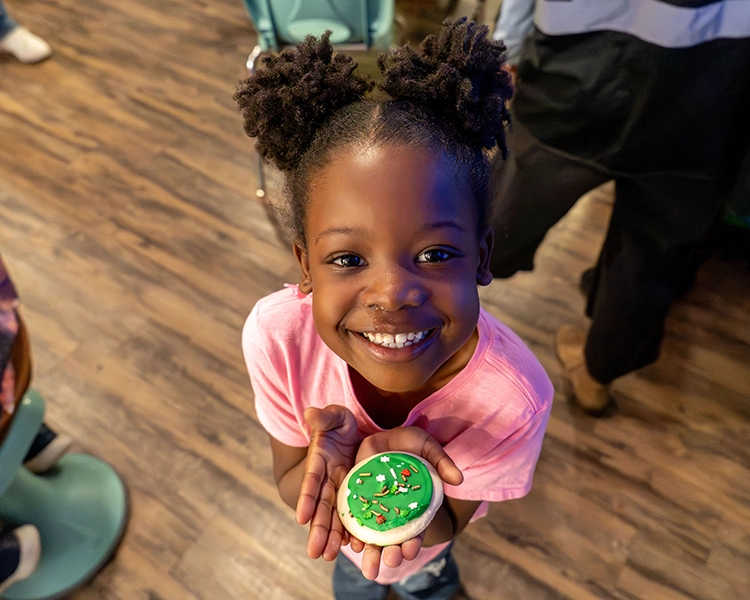Curtis and his children are one of many families to find support at the Mission’s Youth Center. Through intentional relationships and a safe environment, it’s not just a room to play in—it’s a lifeline for families living at The Crossing, offering hope and a better future.
Curtis came to the Mission, filling one of the six rooms recently dedicated for families in crisis. These families, like Curtis’, literally have nowhere else to go and may have more immediate needs. So as a single father to Skylar (10), Sophia (eight) and Sebastien (six), Curtis is grateful for the Mission providing a safe place for his kids.
That’s where the Youth Center comes in. Through homework assistance and after-school activities, the Youth Center helps provide children and teens with a new sense of confidence, responsibility and resiliency.
MC Crawford, children, youth and family manager, described the Youth Center as “a space of respite for our kids. When they come home from school, they—unlike most children—come home to a one bedroom that they share with their entire family. So not a lot of room to play, to express themselves and to develop who they want to be. So we want to make sure that they have the space to do that.”
For Curtis, the support he received from the Youth Center staff upon move-in meant a lot, especially for his son, Sebastien, who is diagnosed with nonverbal autism spectrum disorder. “I’m very surprised at how well they’re equipped with handling kids. It’s pretty outstanding.”


One word Curtis used to describe the Youth Center: Positive
30
Youth engage with the Youth Center on average at a given time.
With the recent addition of a room for ages zero to three and a teen room for ages 12 to 18, the Youth Center is focusing more on supporting the individual needs of each age group.
“It’s us responding appropriately to a need that has been there and seeing a need that is coming up,” Joy McGuire-Olson, associate clinical director, explained. “We are looking at how to build resiliency, being trauma-informed and increasing our intentionality. Kids are just as much experiencing things as their adult parents are. We have an obligation to step up to help facilitate their experiences and their connections.”
While Curtis is receiving the support he needs through counseling and case management, he has been grateful knowing that his kids are “able to have that time to find resources, understand what they can do here and what they can create, learn about finances, and learn about the Bible.”
MC has noticed growth in all of Curtis’ children. “The girls have really come to embrace the youth room and the social environment that it provides,” she said. “They’ve made friends here and I’ve seen them really blossom.”

With Sebastien, the Mission helped connect him to resources for various therapies he needs and helped coordinate his transportation to and from school. There are even volunteers in the Youth Center who are speech therapists who have helped teach him some sign language.
“The other day I was signing ‘more’ to him, like, ‘More swinging?’ out on the playground, and he signed ‘more’ back to me,” MC shared excitedly. “So that is just one example of how consistency and stability can be really beneficial for a person.”
What have you learned since you started coming to the Youth Center?

Skylar
“How to do sixth grade math. I’m in fifth grade.”

Sophia
“That there are people who are kind and nice.”
The Youth Center sees this kind of progress and success in many of the children. MC shared the story of another set of siblings, three and five years old, who had lived on the street and in shelters with their mom, who didn’t talk at all when they moved in.
“Now they come to the youth room running and they’re ‘chatty Kathy’s,’” she said. “The five-year[1]old girl, the fact that she wasn’t speaking at all and now she’s socializing with other kids, I believe—and her mom believes too—that her experience here has redirected her child towards a better path.”
A Glimpse into the Youth Center
“It looks like hugs when they walk in the door and accepting them as they come.” -MC

How do you feel?
With the whiteboard-tables, youth are encouraged to write or draw how they are feeling that day.

Free Time
Playtime is encouraged through toys, arts and crafts and playing on the playground.

Math and Reading Club
Time is spent doing homework, receiving tutoring and furthering their education.
Building up future generations is one way the Mission is moving the needle on family homelessness. “Look at our youth, they’re starting out in homelessness and we’re working to change their direction, so they don’t end up in homelessness too,” MC said. “I’m really proud of the work we’re doing here.”
For Curtis, he’s just grateful. “There are people out there who are able to help, who aren’t looking for something in return, who want positive change, and want to see a better future for people.”

It’s Time for More Bright Futures!
Thank you for caring for children like Skylar, Sophia and Sebastien. Give today to help build up the next generation!








